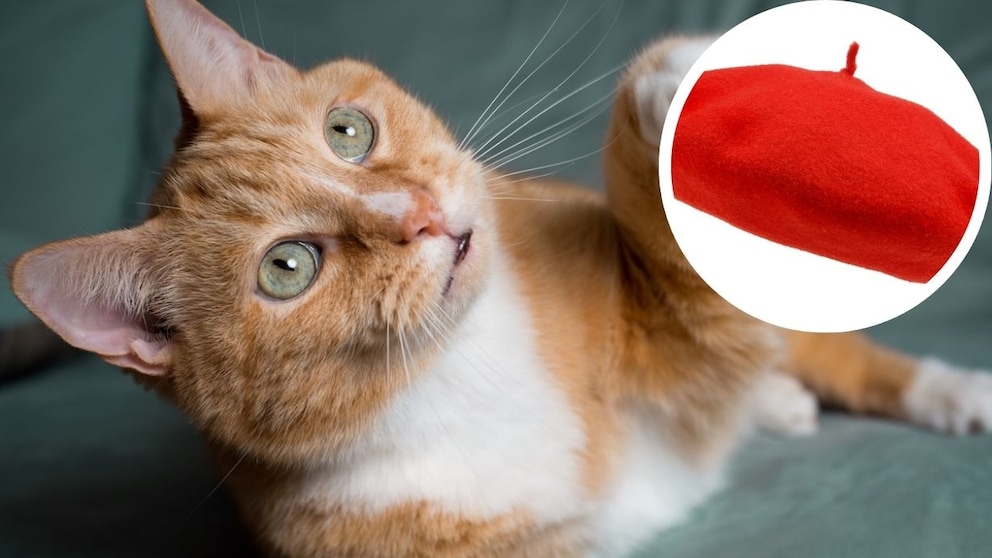March 13, 2025, 8:58 am | Read time: 5 minutes
Oh là là, French flair! An orange and white cat is currently stealing hearts on social media. Because the cat named Fettuccine has developed a passion for his owner’s red beret. But what sounds like a cute obsession could have a completely different background.
A red beret, as a fashion accessory, epitomizes French flair like nothing else — and it seems, for a cat as well. “Fettuccine” is very fond of the headgear on social media, so much so that his owner promptly bought him his own little hat. He now dons it with such elegance that it could even make a Parisian street artist envious. But there could be more to this behavior than just “fashion sense.”
Why the Beret Is So Attractive to the Cat
But let’s start at the beginning: The chic little hat was originally the signature accessory of Lizzie, the cat’s owner — yet her fluffy companion developed what could be described as a disturbing obsession with it. Wherever the beret was, Fettuccine wasn’t far away. He cuddled it, slept on it, and defended it with claws and teeth.
So Lizzie did the only logical thing: in her TikTok video, which has been liked by 46,500 people (as of 13.3.2025), she got him his own! And lo and behold — our little fashion cat was blown away. Now, they walk around the apartment in their twin look and could almost put on their own fashion show in Paris. Très chic!
However, upon closer examination, there are indications that the cat may not have been fond of wearing the hat. Because he is briefly held up to the camera by his owner while wearing the beret. Although the animal does not necessarily show symptoms of stress, he does appear somewhat apathetic. This could be because he is unaccustomed to the little hat on his head or because he has to remain — even if only briefly — in an unnatural position on his owner’s arm. The hat serves no practical function for the cat and is, therefore, essentially superfluous.
From Fashion Icon to Case for Science?
When interacting with the beret, Fettuccine also shows signs of more than just fashion consciousness. The cat salivates over the beret, rubs against it, and sniffs it with great interest. Cats only show a similar reaction to catnip or similar stimulating substances.
It is unclear whether Fettuccine’s owner sprayed the beret with a catnip spray so that he would accept it better. Perhaps she wore it herself, as a hair on the cap might suggest. The cat may have noticed her scent and, therefore, have a positive association with the new accessory. Nonetheless, the characteristics of the French cap itself may also shed light on the cat’s behavior.
After all, our cultural image of cats playing with wool is no coincidence. And it’s not just about funny dancing wool threads, but above all, about the substances contained in real sheep’s wool. First and foremost is lanolin, a natural fat produced by the sebaceous glands of sheep. In hoofed animals, it helps to keep their wool water-repellent and supple.
Lanolin in Wool Can Induce Behavioral Disorders in Cats
In cats, however, lanolin triggers something else. The behavior of Siamese and Burmese cats was investigated in 2015. In particular, the Burmese cats in this study were shown to develop an obsession with wool if weaned from their mother too early (before the 7th week). The researchers suspect an excessive continuation of the sucking behavior of cats weaned too early. The phenomenon is, therefore, also known as wool-sucking.
However, in the Siamese cats studied, it was found that wool-sucking occurred more frequently in conjunction with health problems. This indicates that physical complaints can also trigger or intensify this behavior. However, cats with an unusually strong appetite also tended to suck wool particularly often — possibly because the behavior is a kind of substitute for a lack of food intake.1
Wool Sucking Can Lead to Objects Being Swallowed
So does Fettuccine fulfill the cliché of the always-hungry orange cat, or has he actually developed an obsessive-compulsive disorder? Because while many cats only occasionally suck on the fabric, in some, the behavior can become a true compulsive act (Feline Compulsive Disorder) — comparable to OCD in humans.
If cats start to actually swallow pieces of fabric, there is a risk of intestinal blockage, which, in the worst case, can require surgical treatment. This is also known as pica syndrome. As early as 1997, a study found a very probable link between an obsession with wool and the swallowing of non-edible objects in cats. A full 93 percent of the materials consisted of wool.2

Cat sitter reports These 11 cat breeds particularly like to cuddle

More than 40 percent Study shows that cats retrieve more often than expected

Behavior explained Why do cats lick us? 6 possible reasons
Fettuccine — Beret Lover or Wool-Sucking Candidate?
Whether the felt of the beret reminds the cat of the smell and taste of mother’s milk or is a kind of “pacifier” for him, the owner should not reinforce the behavior any further. It is also impossible to say for sure whether Fettuccine actually suffers from wool-sucking or has simply developed a very pronounced love of French fashion accessories.
As long as he only wears the beret and doesn’t feel constricted by it, everything is fine. However, if Lizzie notices that he is constantly licking or chewing fabric, it would be worth looking at his past development and possible stress factors.
Despite the adorable appearance, Fettuccine’s fascination might have a serious underlying cause. However, if these concerns are unfounded, the motto still stands: Long live fashion — just no berets for lunch, please!

